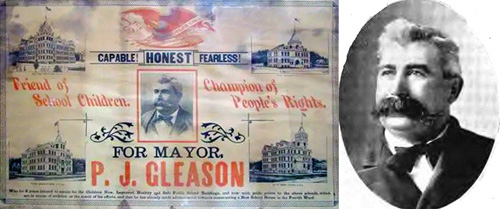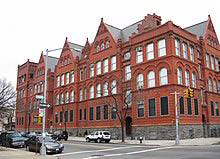Patrick Jerome Gleason, (April 25th 1844 – May 20th 1901) known then to American’s as “Paddy” to others as “Battle-Axe”, was born in Fishmoyne, (Fia Múin), Borrisoleigh, Thurles, Co. Tipperary; latter situated east of the river Gramoge. He was one of ten children born into a family, with a long tradition of fighting local oppression. His father had once boasted, before a magistrate in court, that he was the father of nine boys and he thanked God that each one was a rebel.

The smallest of his nine brothers, Patrick in his prime, stood 6ft-1in in height and weighed almost 18 stone (250 lbs). As a young adult, he excelled at boxing and was a champion local shot putter.
Patrick emigrated to New York at the age of 18 years, in 1862, and fought alongside four of his brothers, for the Union side, in the American Civil War.
War over, he moved to California where his knowledge gained from the manufacture and distillation of contraband Poitín (single malt whiskey) in the remote rural area of Borrisoleigh, (Note: Poitin remained illegal here in Ireland from 1661, until the 7th March 1997) and shrewd speculation in a portfolio of invested stocks, quickly made him a small fortune in California.
He now settled east in Long Island City, setting up a trolley car line, bringing visitors to Calvary Cemetery. Later he would lease personal property to the school district, and form the ‘Citizens Water Supply Co.’ attempting to sell water to Long Island City from his wells.
It was from here he would get involved in local politics and at the age of 42 become the elected mayor of Long Island City; in all three times; from 1887–89; 1890–92, and serving as its last mayor from 1896–97, before his office was eventually incorporated into the City of Greater New York in 1898.
Today, Gleason is remembered as one of the most colourful and charismatic figures in New York City’s history, but also one of the most reviled of characters. A totally domineering figure with a most violent temper he exercised control in the manner of a feudal lord, vastly expanding the size of local government by appointing close friends and supporters to key positions.
Often attacked by his enemies for his alleged corruption, buffoonery and brawling, he was also adored by the Long Island City’s Irish working class and especially school children, for whom he built the stately P.S1 High School, latter today a branch of the Museum of Modern Art.
Possibly best described as a ‘Democrat’, he was voted for simply as ‘Paddy’, and obeyed as ‘Paddy’, by the many people whom he controlled in a domineering, insistent and arrogant manner. Even those who were hostile to him, remembered him as ‘Paddy’ until his death.

He had earned his nickname “Battle-Axe” when the Long Island Railroad (L.I.R.R.) brazenly fenced off its train line, allowing only ticketed passengers to cross its tracks and thus dividing the town from its waterfront, while blocking traffic to the ferry.
Gleason carefully orchestrated a raid against the L.I.R.R. in December 1888. He and some of his workmen converged on 2nd Street and Borden Avenue, informing railroad officials that they had just 30 minutes to remove their fencing, tracks and cars from 2nd Street. When the railroad failed to respond, Gleason, together with his Public Works Commissioner and 12 police officers, chopped down the fences and ripped up the tracks with crowds of delighted onlookers watching. This raid on the railroad earned Gleason the nickname “Battle Axe”, which he proudly adopted as a symbol of his office; wearing a diamond studded axe, as his favourite tie-pin.
Gleason’s volatile temper got him arrested twice. His relationship with the board of aldermen was often tempestuous leading to newspapers refusing to publish his photograph because of their intense dislike and disgust at his dominant actions.
When The New York Times printed an article detailing how Gleason had used his office, as City Mayor, to enrich himself, Gleason simply purchased almost every newspaper printed, greatly reducing the impact of their alleged claims.
In 1890, Gleason drunkenly approached an Associated Press reporter, one Mr George B. Crowley, in a hotel lobby and repeatedly insulted him, calling him a ‘loafer’ and a ‘thief’. Crowley ignored Gleason at first but when words were eventually exchanged, Gleason punched Crowley and kicked him repeatedly in the face. Bystanders took the bloodied Mr Crowley next door into the hotel’s restaurant. When Crowley later returned to the lobby to seek out his fallen spectacles; Gleason again grabbed him and threw him against a nearby cigar stand, breaking the stand’s front glass portal.
Because Gleason was Mayor, police declined to arrest him, without a warrant from a Judge. However, Gleason was eventually arrested and indicted for assault in the third degree, before being sentenced to five days imprisonment in the county jail, with a fine of $250.
The following year, Gleason dislocated the shoulder of yet another man at a meeting of the Board of Health. This time, Gleason was also arrested and charged with assault in the second degree.
Nevertheless under Gleason’s reign, in 1895, the “Queens Gazette” newspaper reported that in Long Island City, “one could walk from one end of Vernon Avenue to the other, the day after the recent (snow) storm and have a clear sidewalk to walk on.” The newspaper commented that this was probably not due to superior civic spirit by local residents, but because of new city ordinances requiring residents to remove snow from their own side-walks. [Maybe we should introduce a similar ordinance in Thurles.]
Gleason’s official office was eventually eliminated some three years later, in 1898, when Long Island City (today in the borough of Queens) joined the merger that created the five boroughs making up New York City.
Gleason’s death in 1901 (Note: he died bankrupt and discredited) was marked by a huge outpouring of grief and the largest funeral the area had then ever seen. Most notable were the hundreds of teary-eyed children who adored Gleason and lined the route to his burial place in Calvary Cemetery, which today can be found at Sec 9, Plot 585, Woodside, Queens County, New York, USA.

Thanks, a great read, and a very interesting story……….for some reason Mussolini springs to mind……he was a fascist……….but at least he made the trains run on time (apparently not true at all)……”Battle-Axe” Gleason was a reviled character etc, but at least on his watch the sidewalks were kept clear of snow